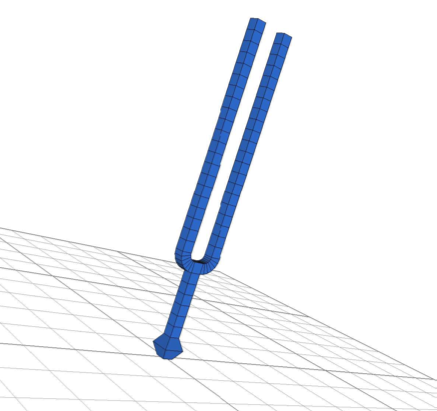Finite Element
This function is used to create a finite element object whose sound properties depend on the user-defined geometry (mesh), material parameters (density, young's modulus , poisson ration, loss parameters) and boundary conditions (the fixed part of the mesh). The dynamic behavior of this object is defined using modal theory. The number of modes generated can be specified by the user.
Finite Element objects will be discussed in their own (forthcoming) section in this new Modalys documentation. For the moment, please refer to the existing Finite element .pdf documentation from 2003.

(make-object 'finite-element ... )
A 'finite-element object can be created using the following Lisp syntax (the default values are shown for each of the physical parameters):
(make-object 'finite-element
(mesh my-mesh)
(block my-sub-mesh)
(modes 40)
(density 7800)
(young 2e11)
(poisson .3)
(freq-loss 1)
(const-loss 1))
The arguments for the physical parameters can be either numerical values or Modalys controllers (either dynamic or constant). If a given parameter is not supplied when using the Lisp syntax, the default parameter value will be used. Unlike other Modalys objects, this object calculates the optimal number of modes based on the other parameters, so a modes parameter does not need to be provided. This object defaults to 20 points in the x direction and 9 in the z direction.
- mesh: The mesh defining the geometry of the finite element object.
- block: The part of the mesh to be constrained (fixed).
- modes: number of modes.
- density: in kg/m^3. See chart of material properties for some appropriate values.
- young: Young's modulus in N/m^2. See chart of material properties for appropriate values.
- poisson: poisson ratio. See chart of material properties for appropriate values.
- freq-loss, const-loss: loss coefficients. See General object information.
The mesh can be obtained using the function (make-mesh ... ) and the related Modalys mesh tools (duplicate ... ) and (transform ... ). Creating meshes for use with the finite-element object is discussed in detail in a separate section.
The block, or constrained part of the mesh, is the part of the mesh that is fixed (immobile) during sound synthesis. The dynamic behavior of an object (and thus its sound) can be completely different depending on the definition of this fixed topology. (To make an analogy, compare the vibration and output sounds of the standard Modalys objects: free-circ-plate and a clamped-circ-plate. Nonetheless, this sub mesh is also discussed in further detail in the section dedicated to finite-element objects.
The other parameters relate to standard Modalys material and modal properties.
A finite-element object can be accessed in any of three directions:
- 'normal
- 'trans0
- 'trans1
You can think of these as corresponding to the z-axis, x-axis and y-axis, respectively.
This is further discussed in the section on finite element objects.
Options
All options regarding the finite element objects will be discussed in their own (forthcoming) section in this documentation.
- Modalys
- Summary
- An Introduction to Modalys
- Getting Started
- Objects
- Object Properties
- Object Reference
- One-Mass - Mono-directional (Harmonic Oscillator)
- Two-Mass - Mono-directional
- Two-Mass - Bi-directional
- String (or Rod) - Mono-directional
- String (or Rod) - Bi-directional
- Tube - open/open
- Tube - closed/open
- Tube - closed/closed
- Rectangular Membrane - Fixed
- Circular Membrane - Fixed
- Rectangular Plate - Fixed
- Circular Plate - Clamped
- Circular Plate - Free
- Rectangular Free Bar
- Violin Bridge
- Cello Bridge
- Jet Object
- Single Point Object
- Radiator Object
- Clone Object
- Save Modal Object
- Read Modal Object
- Resonance Model Object
- Piano Soundboard
- Finite Element
- Object Utilities
- Hybrid Objects
- Accesses
- Connections
- Controllers
- The Modalys Workspace
- Finite Elements
- Appendix
- Index
